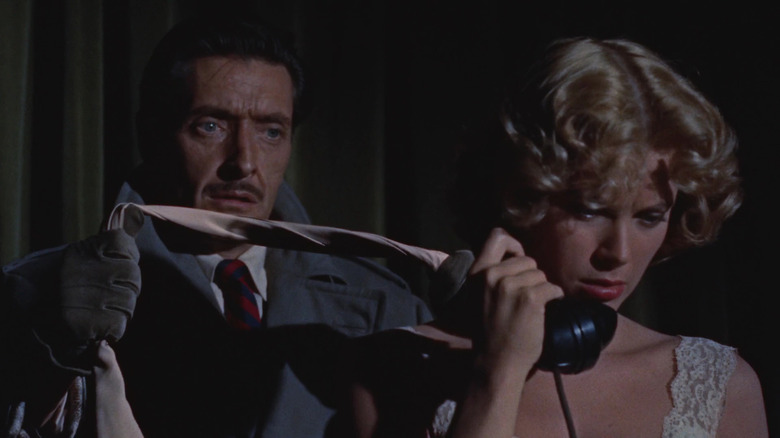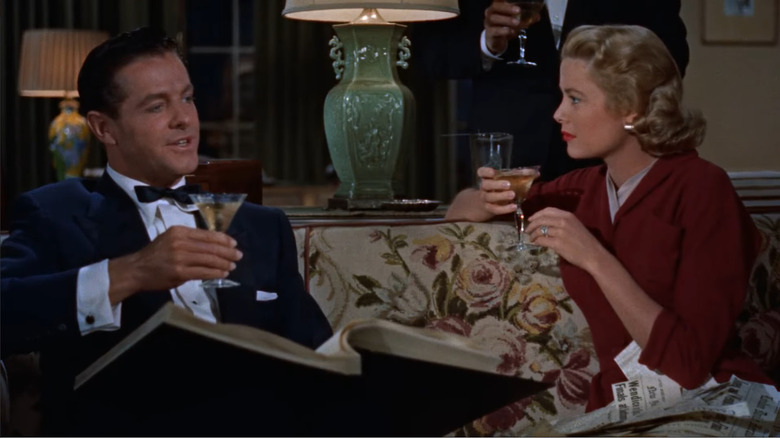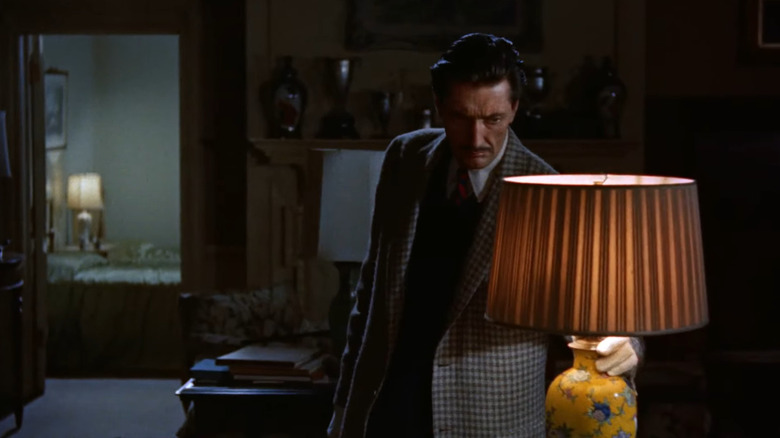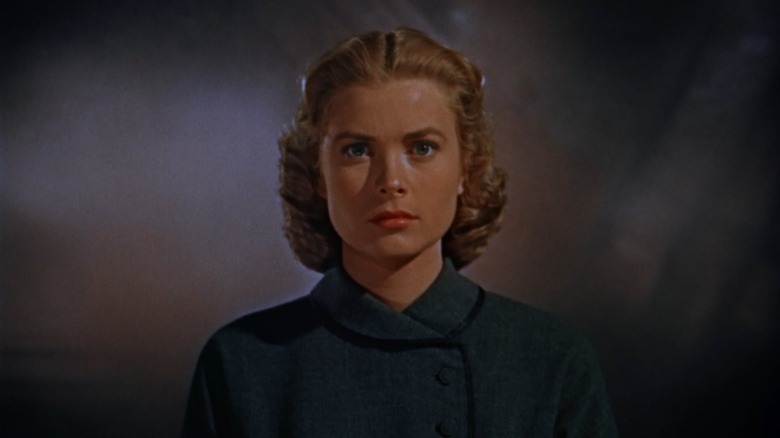Filming Dial M For Murder In 3D Was A Headache For Alfred Hitchcock
Alfred Hitchcock's 1954 film "Dial M for Murder" is one of the filmmakers' delightfully nasty little thrillers wherein the audience is asked to sympathize — and ultimately kind of care for — a horrendous villain. Ray Milland plays Tony, a retired tennis player who has learned that his wife Margot (Grace Kelly) has been having an affair with an American named Mark (Robert Cummings). Rather than merely divorce, Tony elects to have Margot murdered. He colludes with an old criminal buddy named Charles (Anthony Dawson) to commit the murder for him. Charles, being blackmailed, agrees.
What follows is a hotbox procedural tracing Tony's plan for the murder, the elements that go right, and the elements that go horribly, horribly wrong. Most notably: When Charles attacks Margot, she fights back and kills him with a pair of scissors. Oops.
"Dial M for Murder" was filmed in 3D, and it's difficult to understand why. Most of the film takes place in an apartment or some other similarly small location. Nothing about the film's aesthetic seems to dictate the sticking-out-at-you thrill of 3D, nor the you-are-there deep focus of an atmospheric interior.
Even Hitchcock, according to scholar David Bordwell's website, struggled with the bulky cameras and technical limitations of 3D.
Cameras as big as a room
The cameras required to shoot in polarized 3D were, according to Kelly, as big as the room. This is because 3D cameras have two lenses. Each lens behaves as one human "eye," and films from that eye's perspective. When projected, the two perspectives land on the screen simultaneously, also using two polarized lenses. The 3D glasses worm by the audience "blind" one image to one eye and the other image to the other eye, forcing their eyeballs to refocus and combine the two images in their brains, creating the illusion of depth.
"Dial M" was filmed in the traditional polarized process, and not the less expensive red-and-blue anaglyph process.
Filmmakers who shoot in 3D have an interesting new creative decision: Where should the interocular focus of the scene be? That is: How far apart should the 3D camera's lenses be placed in order to simulate a 3D "focus" point for the audience's eyes? Hitchcock was a little flummoxed by this. According to Bordwell, misjudging an interocular focus could mean a slight distortion of the image. Actors would appear further apart than they were meant to look. Hitchcock was also aware of how easy it would be to common mistake made in 3D filmmaking: Placing characters in the foreground of a shot when the 3D focus was meant to rest on background characters. This would make for out-of-focus foreground figures that appeared to extend over the audience's heads. It's worth noting that even modern 3D filmmakers make this error.
R.I.P. common filmmaking techniques
Hitchcock, as such, had to dispense with some common filmmaking instincts. The notion of filming a conversation in shot-reverse-shot had to be ignored as well. In most films, when two characters converse, a filmmaker will typically stage it like a play, with two characters facing each other in profile in a wide shot. The filmmaker will then move the camera onto the "stage" with the actors, and film each side of the conversation over the shoulder of each character. In such shots, in many cases, the back of the character in the foreground will be in the frame. In 3D, an over-the-shoulder shot was out of the question, as it would make for a looming shadow right up against the audience's eyes.
Hitchcock had the additional problem of shooting "Dial M" in a 1.85:1 aspect ratio. 1953 saw the release of "The Robe," the world's first Cinemascope feature film, and throughout 1954, many studios encouraged filmmakers to adopt a wider screen than the previously-used 1.37:1 Academy standard. With a wider screen and a 3D lens, Hitchcock had to conceive of a far simpler mise-en-scène than he was accustomed to. He, by technical necessity, had to make "Dial M" look as utilitarian as possible.
If one knows about the history of three-strip Technicolor, one knows that it — as the name implies — required three separate strips of film run through a camera simultaneously. The mid-'50s saw the popularization of a single-strip color film process that allowed for smaller color cameras. "Dial M" was indeed filmed in a single-strip process — Cinemascope and 3D wouldn't have been possible without a single-strip camera — but 3D and Cinemascope required enormous cameras of their own. Nothing was solved.
Hitchcock/Truffaut
Ironically enough, it was all the technical limitations of 3D cameras and single-strip color that prevented Hitchcock from taking full advantage of the medium. Because had to film with such wide open areas and keep the frame uncluttered, he could only stage the action in "Dial M" as if it was a play. As such, the 3D is not exploited to its full potential. The film, although possessed of a wicked murder plot, emerges more as a technical exercise than a major work.
Hitchcock would go on to lament his frustrations in the 1985 interview book "Hitchcock Truffaut," a necessary text for any aspiring cinephile. In it, Hitchcock and François Truffaut interviewed one another about their philosophies and respective oeuvres. Hitchcock openly admitted to Truffaut that he was only able to stage "Dial M" as a theatrical experience on camera. His exact words were:
"I just did my job, using cinematic means to narrate a story taken from a stage play ... I think that's the job of any craftsman, setting the camera up and photographing people acting. That's what I call most films today: Photographs of people talking. It's no effort to me to make a film like 'Dial M for Murder' because there's nothing there to do."
However visually limited "Dial M for Murder" may be, Hitchcock still worked with a wicked script full of his trademark gallows humor, and got some great performances out of Milland and Kelly. Hitchcock may feel his film is a lesser work, but it's still a blast to watch.



